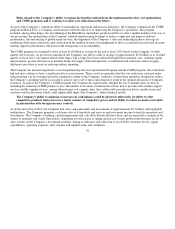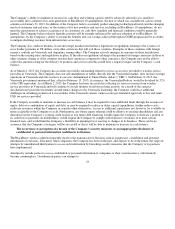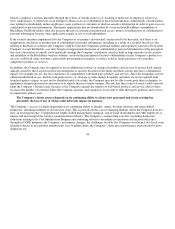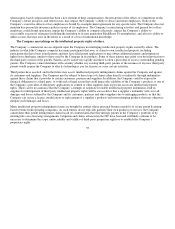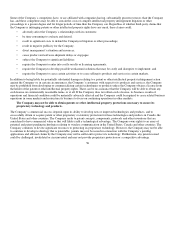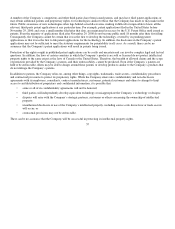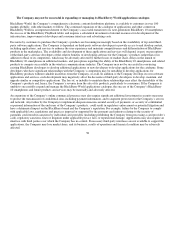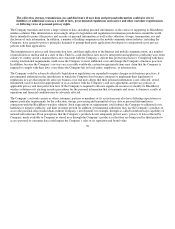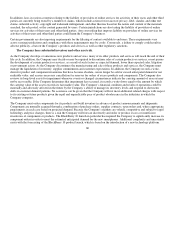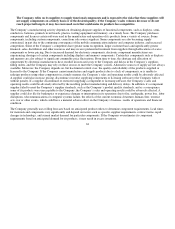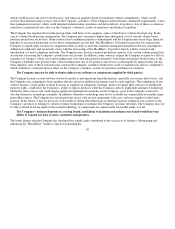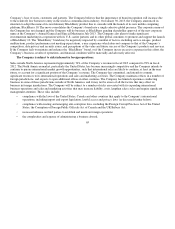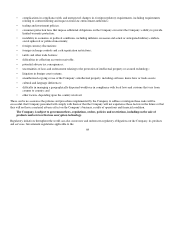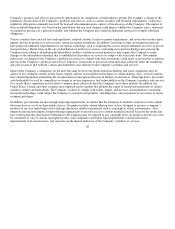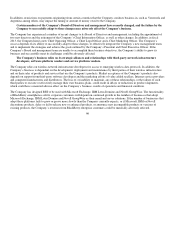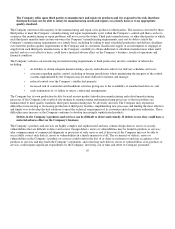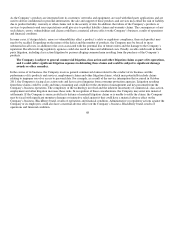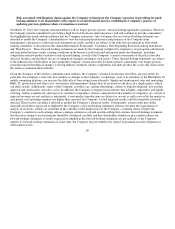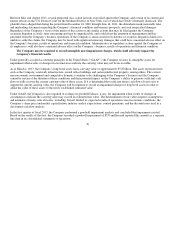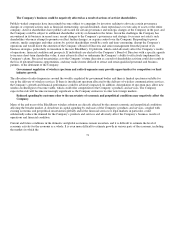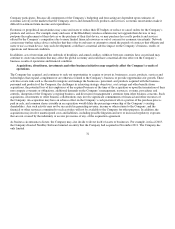Blackberry 2013 Annual Report Download - page 69
Download and view the complete annual report
Please find page 69 of the 2013 Blackberry annual report below. You can navigate through the pages in the report by either clicking on the pages listed below, or by using the keyword search tool below to find specific information within the annual report.
which would increase the risk of obsolescence, and financial penalties based on minimum volume commitments, which would
increase the manufacturing costs per unit of the Company’s products. If the Company underestimates component requirements, it may
have inadequate inventory, which could interrupt manufacturing operations and delay delivery of products. Any of these occurrences
could have a material adverse effect on the Company’s business, results of operations and financial condition.
The Company has negotiated favorable pricing terms with many of its suppliers, some of which have volume-based pricing. In the
case of volume-based pricing arrangements, the Company may experience higher than anticipated costs if current volume-based
purchase projections are not met. Some contracts have minimum purchase commitments and the Company may incur large financial
penalties or increased production costs if these commitments are not met. The BlackBerry 10 launch in particular has required the
Company to significantly increase its component orders in order to meet the estimated anticipated demand for the new smartphones.
Additional complexity and uncertainty exists with the forecasting of the BlackBerry 10 product launch, which is based on the
introduction of a new technology platform. The Company may also have unused production capacity if its current volume projections
are not met, increasing the Company’s production cost per unit. In addition, some contracts require the Company to agree to a flat fee
regardless of volumes, which can result in higher unit costs than anticipated if demand is lower than anticipated. In the future, as the
Company establishes new pricing terms, reduced demand for any of its products and services could negatively impact future pricing
from suppliers. Any of these outcomes may result in the Company’s products being more costly to manufacture and less competitive,
which could have a material adverse effect on the Company’s business, results of operations and financial condition.
The Company may not be able to obtain rights to use software or components supplied by third parties.
The Company licenses certain software used in its products and operations from third parties, generally on a nonexclusive basis, and
the Company uses components from suppliers that are reliant on intellectual property used by such suppliers. The termination of any
of these licenses, or the failure of these licensors or suppliers to adequately maintain, protect or update their software or intellectual
property rights, could delay the Company’s ability to ship its products while the Company seeks to implement alternative technology
offered by other sources and could require significant unplanned investments on the Company’s part if the Company is forced to
develop alternative technology internally. In addition, alternative technology may not be available on commercially reasonable terms
from other sources. The Company has not entered into source code escrow agreements with every software supplier or third party
licensor. In the future, it may be necessary or desirable to obtain other third-party technology licenses relating to one or more of the
Company’s products or relating to current or future technologies to enhance the Company’s product offerings. The Company may not
be able to obtain licensing rights to the needed technology or components on commercially reasonable terms, if at all.
The Company’s business depends on a strong brand, and failing to maintain and enhance our brand would hurt our
ability to expand our base of users, customers and partners.
The brand identity that the Company has developed has significantly contributed to the success of its business. Maintaining and
enhancing the “BlackBerry” brand is critical to expanding the
62


